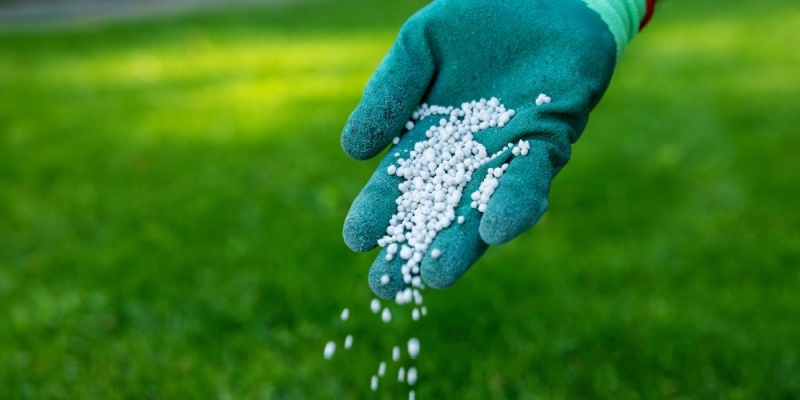Fertilization is often misunderstood by many Columbus homeowners. Some apply too much, hoping for faster results, while others skip it entirely, concerned about environmental impacts. At Weed Busters, we believe in a balanced, science-based approach to lawn fertilization that promotes health, sustainability, and beauty. Let’s explore the truth about feeding your Central Ohio lawn this summer.
Understanding What Your Grass Really Needs
The NPK Basics
Fertilizers typically contain three primary nutrients, represented by the three numbers on every fertilizer package:
- N (Nitrogen): Promotes leaf and stem growth, creates rich green color
- P (Phosphorus): Supports root development and seedling growth
- K (Potassium): Enhances overall hardiness, disease resistance, and drought tolerance
For established Central Ohio lawns in summer, a fertilizer with higher nitrogen and potassium but lower phosphorus (such as 18-2-12) is generally appropriate, though soil testing may indicate different needs for your specific lawn.
Secondary and Micronutrients
Beyond NPK, quality fertilizers often contain:
- Iron: Enhances green color without excessive growth
- Magnesium: Crucial for chlorophyll production
- Sulfur: Helps plants utilize nitrogen effectively
These additional nutrients can make a significant difference in lawn appearance, especially during summer stress periods common in Central Ohio.
Timing: When to Fertilize Ohio Lawns This Summer
Early Summer (Late May/Early June)
This application helps your lawn transition from spring growth to summer stress conditions. For Columbus lawns:
- Use a slow-release fertilizer with moderate nitrogen levels
- Apply after spring growth surge but before intense summer heat
- Include iron if your lawn needs color enhancement
Mid-Summer (Late July)
Many lawn care programs skip mid-summer feeding, but a light application can be beneficial if:
- Your lawn shows signs of nutrient deficiency (yellowing, slowed growth)
- You’re using irrigation to maintain growth during dry periods
- You apply at half the normal rate using a product designed for summer application
Late Summer (Late August/Early September)
This is arguably the most important fertilization of the year for Central Ohio lawns:
- Supports recovery from summer stress
- Prepares grass for fall growth period
- Strengthens roots before winter dormancy
Use a fertilizer with slightly higher potassium at this time to enhance winter hardiness.
Application Methods: Getting It Right
Broadcast Spreaders
For most homeowners, a rotary/broadcast spreader provides the most even coverage:
- Calibrate your spreader according to the fertilizer label
- Make two passes at half-rate in perpendicular directions
- Overlap slightly between passes to prevent striping
Drop Spreaders
These provide more precise control around landscape features:
- Ideal for smaller lawns or precise boundaries
- Require more careful attention to ensure no gaps between passes
- Generally apply fertilizer more slowly than broadcast models
Liquid Applications
Professional services often use liquid fertilizers because they:
- Provide more immediate nutrient availability
- Can be combined with other treatments
- Offer more uniform coverage
Common Fertilization Mistakes to Avoid
Over-Application
Applying too much fertilizer can:
- Burn grass roots and blades
- Promote excessive top growth at the expense of root development
- Contribute to thatch buildup
- Create runoff that pollutes waterways
Always follow label rates and remember that more is definitely not better.
Poor Timing
Avoid fertilizing:
- During drought conditions when grass is dormant
- Before heavy rain that can cause runoff
- During the hottest part of summer, unless using a specific summer-formula product
- Too late in fall when grass isn’t actively growing
Uneven Application
Striped lawns with alternating light and dark green bands indicate uneven fertilization. Prevent this by:
- Maintaining consistent walking speed
- Ensuring proper spreader calibration
- Making perpendicular passes
- Closing the spreader when turning or stopping
Environmentally Responsible Fertilization
Reduce Runoff
- Sweep granules off hard surfaces back onto the lawn
- Avoid fertilizing before heavy rain
- Create buffer zones near water features
- Consider using fertilizers with slow-release nitrogen
Soil Testing
Professional soil testing every 2-3 years helps you:
- Apply only the nutrients your lawn actually needs
- Identify pH imbalances that affect nutrient availability
- Track improvements in soil health over time
The Weed Busters Difference
Our professional fertilization programs for Columbus lawns are designed to:
- Provide the right nutrients at the right time based on local growing conditions
- Utilize professional-grade products with enhanced efficiency
- Minimize environmental impact through precise application
- Adjust for your lawn’s specific needs and your personal goals
Summer fertilization, when done correctly, helps your lawn withstand heat, drought, and pest pressure while maintaining the vibrant green color you desire. Contact Weed Busters today to discuss a custom fertilization program tailored to your Central Ohio lawn’s specific needs.

